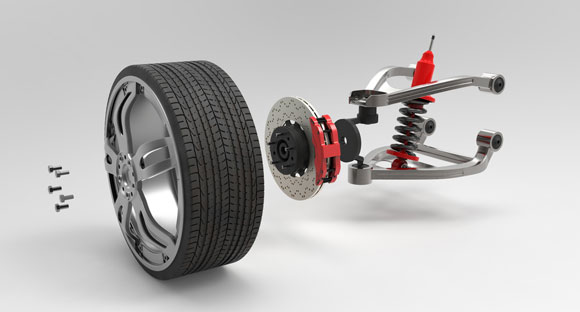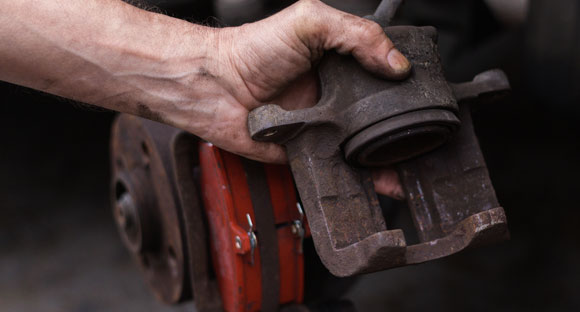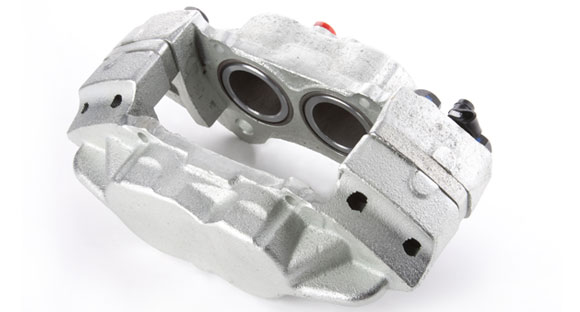Brake Caliper Replacement
Brake Caliper Replacement Procedure:
Remove the wheel
- Remove lug nuts
- Remove the wheel
Access the brake caliper
- Remove the caliper and pads
- Detach hydraulic brake line
Install new caliper to OEM specs
- Procure new OEM caliper
- Install new caliper onto brackets
- Replace brake pads
- Reinstall hydraulic brake line
Bleed the brake system
- Open bleeder valve
- Bleed hydraulic fluid
- Remove air bubbles
Install wheel & test brakes
Test drive the vehicle
Brake Caliper Replacement
Is your vehicle due for a brake caliper replacement? Cougar Tire & Auto is Provo’s brake specialists. We have the experience and know-how to replace your brake calipers at our shop right here in Provo. We can do it better, faster, and cheaper than anywhere.
Most modern vehicles come with disc brakes in the front and either disc brakes or drum brakes in the back. Brake calipers are a critical component of any brake system. Their main function is to essentially squeeze the pads together on the surface of rotating disc rotors as the wheel turns to slow or stop your car.

Brake Caliper Replacement in Provo
Over time, brake calipers can become rusted or corroded. When this happens the caliper can actually seize and stop working altogether, causing the brakes to either not work efficiently or potentially even fail altogether.

In addition to proper scheduled maintenance, brake calipers should be checked regularly to ensure they are working properly. We recommend checking brake calipers at every oil change interval.
How do brake calipers work?
The brake caliper fits over the disc rotor like a clamp. Inside each brake caliper are metal plates bonded with high friction material called brake pads. Outboard brake pads are on the outside of the rotors (toward the curb). The inboard brake pads are on the inside of the rotors.
When you apply pressure to the brake pedal, brake fluid from the baster cylinder creates hydraulic pressure on pistons located in the brake caliper forcing the pads against the rotor. This makes the rotors slow down which in turn slows down your wheel until you eventually come to a stop.

Brake Calipers
What’s important to a brake caliper is that those pistons can move easily so the pressure to the pads and rotors are consistent and therefore safe. Over time, the brake caliper pistons can become difficult to slide in and out. When this happens, it can clamp down on your brake rotors causing premature brake pad wear. It can also cause you to lose gas mileage if not taken care of. If left without repair, the caliper can fail which can cause loss of braking power.
How long do brake calipers last?
Depending on how you drive, the exact vehicle you own, and other factors, your brake calipers could last several years. In some cases, brake calipers can last for up to 70,000 to 90,000 miles or more.
However the best way to know when you should consider replacing brake calipers is to go by the vehicle manufacturer’s scheduled maintenance. If you would like to know when the manufacturer of your vehicle recommends caliper replacement, give us a call and we’ll look it up for you.
How much does is cost to replace brake calipers?
The cost to replace brake calipers can vary greatly depending on the year, make, and model of your vehicle. The average cost to replace one brake caliper can range from between around $258 to about $766. It all depends on the cost of parts for your vehicle and the time it takes to replace it. For an exact instant quote on your vehicle, please call us at (801) 374-6240.
How we perform a brake caliper replacement
Access the brake caliper
To access the brake system, we first lift the vehicle up in the air using our heavy duty car lift. Once on the lift, we can remove the wheel and get to the brake caliper. We always thoroughly inspect all brake components prior to starting a brake caliper replacement procedure. We look for leaks, check brake pad thickness, determine if the brake system is working correct or whether any other parts may need to be replaced to ensure a safe brake system upon completion.
Remove the caliper and pads
Using the proper-sized wrench and sockets, we remove the brake caliper mounting bolts and loosen the caliper from its position by rocking the caliper back and forth to create an air gap between the caliper piston and brake pads. We then carefully slide the brake caliper from the brake rotor. Once the caliper is removed, we also remove the brake pads from the caliper bracket and check for pad thickness.
Detach the hydraulic brake line
Once the caliper mounting bolts and caliper has been removed, we remove the brake flex hose from the frame brake line and use a rubber cap to plug the line so hydraulic fluid does not drain out of the master cylinder.
Install a new caliper to the hydraulic brake line
Using only the highest quality parts, we acquire a new OEM caliper as specified by the manufacturer. We then secure the hydraulic hose onto the intake port of the new caliper and screw on the banjo bolt by hand to secure it in place before we tighten it with a ratchet.
Install the new caliper
With the new caliper attached to the brake line, we reinstall the caliper back onto the caliper bracket using the correct bolt holes. We apply an anti-seizing fluid on the bolts before we reinsert them to make it easier to remove them next time.
Bleed the brake system
Once the brake caliper and pads are reinstalled and the components are back in place, we bleed the brake system to avoid any air pockets that may have been introduced when the brake line was disconnected.
Install the wheel and test
After the new brake caliper is in place, the pads are reinstalled, and the line is bled, we reinstall the wheel back onto the car and test to make sure the brakes are performing correctly. We test drive the vehicle to make sure the car is safe to drive and that the new caliper is functioning as it should.
Common symptoms to look for
It’s not always easy to know when a brake caliper is not functioning correctly or whether it may be due for replacement. The best way to know for certain is to bring your car in for a free brakes check. A brake check only takes about 15 minutes and is 100% free. We’ll put your vehicle on our lift to raise it up in the air and take the wheels off to access the brakes. Then we’ll be able to give you a full report on the condition of your brake pads, rotors, calipers and hydraulic lines.
Here are a few things to watch for if you suspect you may have brake caliper problems:
- Unusual squealing noise from brakes
- Hard pull to left or right when braking
- Brakes feel soft or spongy
- Brake pedal is easier or harder to push
- Brake pedal goes all the way to the floor when pressed
- Brake fluid is leaking
Brake pad are the component of your brake system that touch the surface of your brake discs or drums, depending on which brake system your vehicle has. Brake pads are composed of tough friction material bound to steel backing plates. Brake pads naturally wear down over time and should be checked often and replaced when the thickness becomes less than the tolerance specified by the vehicle manufacturer.
Brakes will “squeal” when your brake pads become worn or glazed over. This is a common and intended feature to let you know it’s time for a brake pad replacement. Depending on whether your brakes are drum brakes or disc brakes, your brakes can accumulate brake dust which can also make the brakes squeak when you apply the brakes. This can usually be fixed by cleaning the brake dust out of the system, applying brake spray which can help quiet the squeak, or if replacing the brake pads and rotors.
Depending on your driving habits and general driving conditions in the area you live, high quality brake pads can typically last for up to 3 to 5 years or longer. Brake rotors can last for up to 70,000 miles or more. Both brake pads and rotor should be inspected at least every time you come in for an oil change.
A brake system flush is when the brake fluid is drained out of the brake system and new fluid is added. Brake system flushes help ensure the proper functioning and longer life span of the brake system.
Each vehicle manufacturer makes recommendations on how and when to change your vehicle’s brake fluid. The timing varies by the type, make and model of the car, the driving conditions you encounter, and other manufacturer recommendations. A good rule of thumb is to have your brake fluid checked every time you come in for an oil change. In general, brake fluid should be changed about every four to five years.
Why Cougar Tire & Auto for Brake Caliper Replacement in Provo?
Cougar Tire & Auto prides itself on safety, reliability, honesty and affordability. When you choose Cougar Tire & Auto in Provo for brake caliper replacement you can rest assured the job will be done right. We’ll do it better, faster, and more efficiently than any other shop in Utah and we’ll make sure you get the absolute best price on brake caliper replacement anywhere.